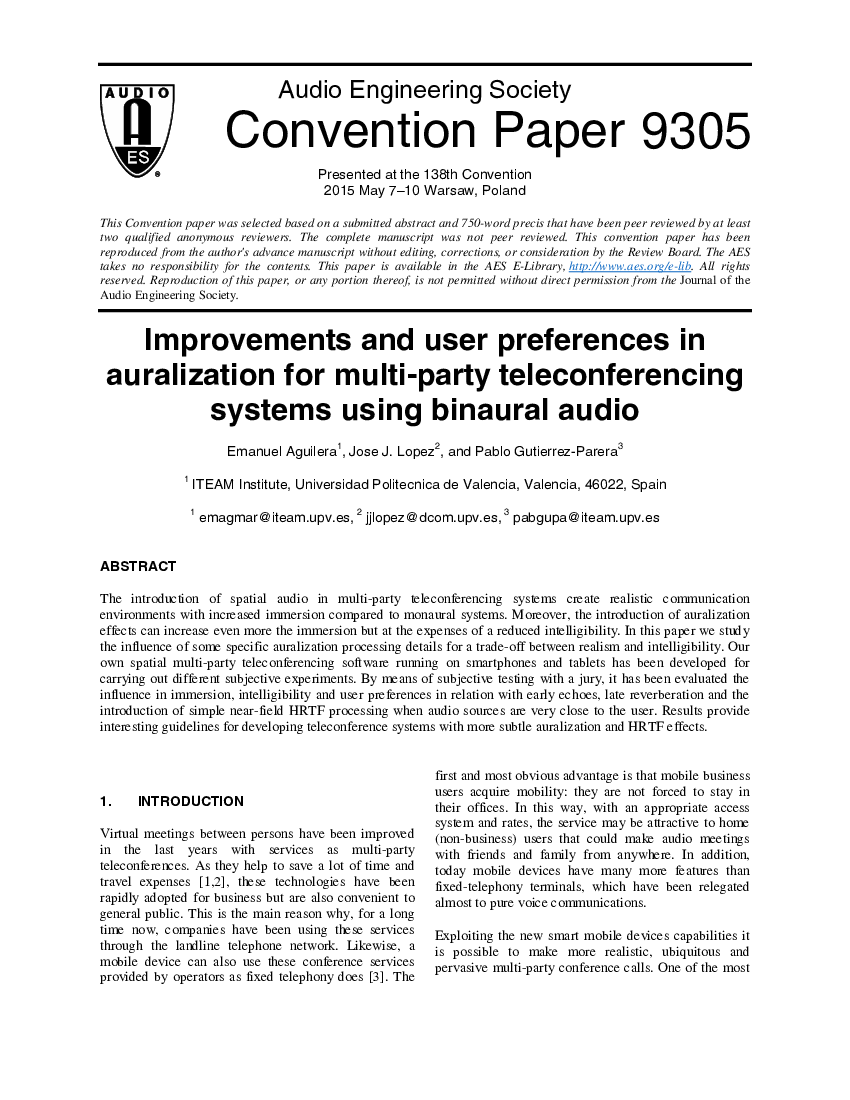Home / Publications / E-library page
You are currently logged in as an
Institutional Subscriber.
If you would like to logout,
please click on the button below.
Home / Publications / E-library page
Only AES members and Institutional Journal Subscribers can download
The introduction of spatial audio in multi-party teleconferencing systems create realistic communication environments with increased immersion compared to monaural systems. Moreover, the introduction of auralization effects can increase even more the immersion but at the expenses of a reduced intelligibility. In this paper we study the influence of some specific auralization processing details for a trade-off between realism and intelligibility. Our own spatial multi-party teleconferencing software running on smartphones and tablets has been developed for carrying out different subjective experiments. By means of subjective testing with a jury, it has been evaluated the influence in immersion, intelligibility, and user preferences in relation with early echoes, late reverberation, and the introduction of simple near-field HRTF processing when audio sources are very close to the user. Results provide interesting guidelines for developing teleconference systems with more subtle auralization and HRTF effects.
Author (s): Aguilera, Emanuel; Lopez, Jose J.; Gutierrez-Parera, Pablo
Affiliation:
Universitat de Valencia, Valencia, Spain
(See document for exact affiliation information.)
AES Convention: 138
Paper Number:9305
Publication Date:
2015-05-06
Import into BibTeX
Session subject:
Applications in Audio
Permalink: https://aes2.org/publications/elibrary-page/?id=17729
(863KB)
Click to purchase paper as a non-member or login as an AES member. If your company or school subscribes to the E-Library then switch to the institutional version. If you are not an AES member Join the AES. If you need to check your member status, login to the Member Portal.

Aguilera, Emanuel; Lopez, Jose J.; Gutierrez-Parera, Pablo; 2015; Improvements and User Preferences in Auralization for Multi-Party Teleconferencing Systems Using Binaural Audio [PDF]; Universitat de Valencia, Valencia, Spain; Paper 9305; Available from: https://aes2.org/publications/elibrary-page/?id=17729
Aguilera, Emanuel; Lopez, Jose J.; Gutierrez-Parera, Pablo; Improvements and User Preferences in Auralization for Multi-Party Teleconferencing Systems Using Binaural Audio [PDF]; Universitat de Valencia, Valencia, Spain; Paper 9305; 2015 Available: https://aes2.org/publications/elibrary-page/?id=17729
@article{aguilera2015improvements,
author={aguilera emanuel and lopez jose j. and gutierrez-parera pablo},
journal={journal of the audio engineering society},
title={improvements and user preferences in auralization for multi-party teleconferencing systems using binaural audio},
year={2015},
number={9305},
month={may},}